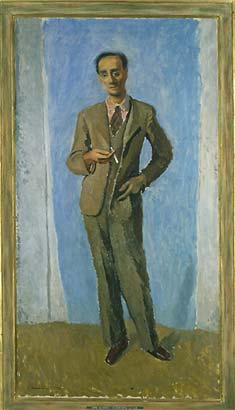



In post-war Finland while Heinonen was rector of the Academy of Fine Arts he adeptly employed his contacts to art metropoles he had established across Europe. He undoubtedly steered the concept and use of colour of an entire generation of Finnish artists. Professor Heinonen is still painting – this in itself is a remarkable achievement.
Heikki Tuominen, owner of he Pyhäniemi Manor House, has put together an interesting cross-section of Heinonen's oeuvre; his exhibition features 60 works
Ranging from the 1930's to the present day. The last major show of Heinonen's work was in 1979 in the City of Helsinki Art Gallery. Although 16 years feature a rather short phase in the life of this artist – it is 16 years in which a whole new generation has grown up, a generation quite unfamiliar with the works of Aarre Heinonen.
A master of portrait painting
The Pyhäniemi exhibition features not only Heinonen's mastery of landscape and still life painting but also focuses on his nudes and female portraits. Indeed the works hailing from the nude painting school of the 1930's have been excellently selected as entirely typical of the artistic mood of the time. These works portray the women of the 30's – ranging from the "femme fatale" to the purity of the "little girl lost". Take for example, the ladies in black "Maire von Bonsdorff" and "Frau Helkama"…here we see no trace of grieving widows but two very calm, collected and rather mysterious women of the world. Lady in black, the portrait of Frau Helkama, was a commissioned work that was not redeemed – the reason for which remains a mystery.
The artist's painting of his wife, Tuomi, is a startlingly fine portrait in which Heinonen succeeds in portraying the androgenous, boyish look so typical of women in the 30's.
Heinonen's best known portrait, currently in the Lahti Municipal Art Gallery collection, is his painting of the art critic, E.J. Vehmas. Here again we see the artist masterfully portraying the aesthetics of the day back in the 1930's – we see the art critic as a rather feminine, flirtatious, decadent figure – and people who actually knew E.J. Vehmas claim it is an excellent portrait of the art critic. The painting also provides a model for many “Little Vehmas” of today.
Before becoming a painter, Heinonen studied music at the Helsinki Conservatory. Against this background one wonders to what extent music and rhythm influence the techniques he employed in his still life and portrait painting, or for that matter, if perhaps his pharmacy studies prompted the very "precise" manner in which he applies and combines colour in his paintings. He developed his painting technique during his studies in Antwerp.
"A deep and fine feeling"
Heinonen was internationally acclaimed as a "non-expressionist", a representative of the "Paris tradition" and "the age of pure painting" – and this even in Paris itself. An exhibition of his work held in the French capital in 1951 received the following comment from the L'Aube magazine:
"The magnanimity of his nuances, the finesse in his use of colour in his paintings along with the clarity and purity of his water-colours express the depth and refinement of feeling that the works of Aarre Heinonen exude, the works of a master."
Heinonen's art has lost nothing of its freshness and relevance.
Author:
Anne Rouhiainen (Helsingin Sanomat, 10.08.1995)
Translation:
Peggy Graham-Sechtem










